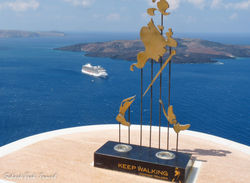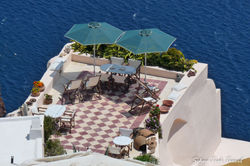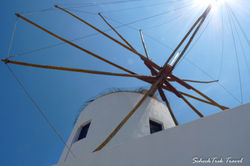Santorini, Greece
 Views Don't Get Much Better |  Our Client Bob Enjoying His ViewBob and Becky stayed at Canaves Oia Suites, overlooking the caldera in Santorini. |
|---|---|
 What's Not to Love About This?Our client Becky drinks in the view from Canaves Oia Suites. |  Al Fresco Dining in SantoriniHow would you like to have him serving you your lunch in this setting? |
 Friends |  The Mule Driver in Santorini |
 Johnny Walker: Keep WalkingEncouragement for those who committed to hoofing it on their own up to the top of Santorini. |  Blue-Domed ChurchThere are many blue-domed churches in Santorini. |
 Glimpse through Open Doors in Oia |  A Windmill Cafe in Santorini |
 Picture Yourself Here |  Beautiful Greek Architecture |
 Santorini's Famous Blue Dome |  Windmill in Santorini |
Santorini is quintessential Greece, displaying its whitewashed villages with blue trim, windmills, and to-die-for views.
It was an enormous volcanic explosion—said to be the largest in recorded history—that produced Santorini’s famous caldera some 3,600 years ago. To put this in a modern context, it is believed to have spewed 35 times as much rock and ash as did Mount St. Helens. The resulting hole, now filled with water, measures 7.5 x 4.3 miles and is almost 1,300 feet deep. Despite the destruction it wrought at the time, that eruption did wonders for the future tourism of Santorini!
Santorini is a favorite destination for cruise ships. It could be argued that no cruise of the Greek Isles would be complete without it.
As the ships are obviously at sea level, the first decision to make is how to tackle the 853-foot ascent. The choices are: (1) cable car, (2) mule or (3) by foot. The latter involves a 45-minute hike up the same paved surface the mules use. Even though the path does get cleaned, it’s a rough haul. Our cruise director said he’d done the walk once, but that he wasn’t likely to do it again. We opted to ride the mules on the way up, and I loved it! It was the highlight of my day and one of the memorable highlights of the trip.
What I’d read beforehand made it sound a lot more precarious than what it seemed to us in person. The path is quite a bit wider than we’d imagined, and there is a wall (albeit, a low wall) on the sea/drop-off side. Tip: some have said the mules get too close to the wall and their legs or shoes get scraped. This is not a place for your Ferragamos! When they brushed me against the wall, I gently pressed into the animal’s side with the stirrup, and he moved out. Al pushed on his mule’s neck, which worked as well. He also said he talked to the animal and told it to “move over.” :)

Mules await riders in Santorini

The views of Santorini’s caldera were amazing, and they just kept getting better and better the higher we went.
Arriving at the top in Fira (also called Thira), we made our way to the bus station, asking locals for directions. Fira is pretty, but we first wanted to make sure we had plenty of time in Oia (pronounced EE-ah), which is the iconic part of Santorini. The bus was very modern and clean – and full of tourists (we don’t know what the locals ride) – so for only €1.60 each (which is paid after the bus is en route), we were set for the comfortable, 30-minute ride to Oia. It went like clockwork. (The return to Fira, however, was something else again, and not an experience that we could recommend.)
There was good shopping in Oia...

Handmade dolls and marionettes in Santorini
…and plenty of art galleries.

Sea horse sculpture at an art gallery in Oia, Santorini

Fish sculpture at a Santorini art gallery
And then, there's just...art.

Unusual art in unusual places in Santorini
People watching was fun.

Santorini has lots of cafés with views. Before heading back to the ship, we enjoyed one such café and tried to etch the view into our memories forever.

Al and Vicki Scheck enjoy a café in Oia, Santorini, Greece
One is cautioned about taking the donkeys back down the hill, as they rush past each other to get to their food at the bottom, and that can be a little precarious. So we took the cable car for the descent, which also provides a great view and is quicker (though there can sometimes be a line).
We planned a customized land tour for a couple of clients, who enjoyed several days on Santorini. Our thanks to them for generously allowing us to share some of their travel photos below.


Clients Bob and Becky enjoy the view from Canaves Oia Suites. What's not to love about this?
In looking out over the caldera and Aegean Sea from heights of up to almost 1000 feet, your eyes will feast on some of the most breathtaking panoramas the world has to offer. As one visitor said, “You will remember the view for the rest of your life.”




